5 语法复习五:强调句、It的用法、省略和插入语 16开
- 格式:doc
- 大小:65.50 KB
- 文档页数:12
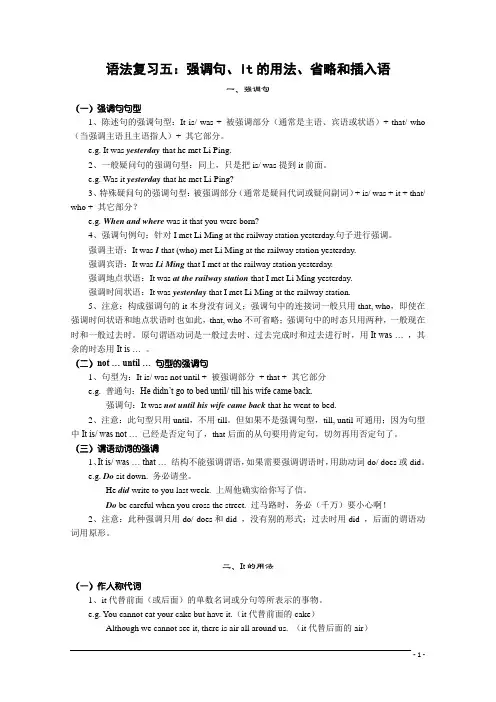
语法复习五:强调句、It的用法、省略和插入语一、强调句(一)强调句句型1、陈述句的强调句型:It is/ was + 被强调部分(通常是主语、宾语或状语)+ that/ who (当强调主语且主语指人)+ 其它部分。
e.g. It was yesterday that he met Li Ping.2、一般疑问句的强调句型:同上,只是把is/ was提到it前面。
e.g. Was it yesterday that he met Li Ping?3、特殊疑问句的强调句型:被强调部分(通常是疑问代词或疑问副词)+ is/ was + it + that/ who + 其它部分?e.g. When and where was it that you were born?4、强调句例句:针对I met Li Ming at the railway station yesterday.句子进行强调。
强调主语:It was I that (who) met Li Ming at the railway station yesterday.强调宾语:It was Li Ming that I met at the railway station yesterday.强调地点状语:It was at the railway station that I met Li Ming yesterday.强调时间状语:It was yesterday that I met Li Ming at the railway station.5、注意:构成强调句的it本身没有词义;强调句中的连接词一般只用that, who,即使在强调时间状语和地点状语时也如此,that, who不可省略;强调句中的时态只用两种,一般现在时和一般过去时。
原句谓语动词是一般过去时、过去完成时和过去进行时,用It was … ,其余的时态用It is … 。
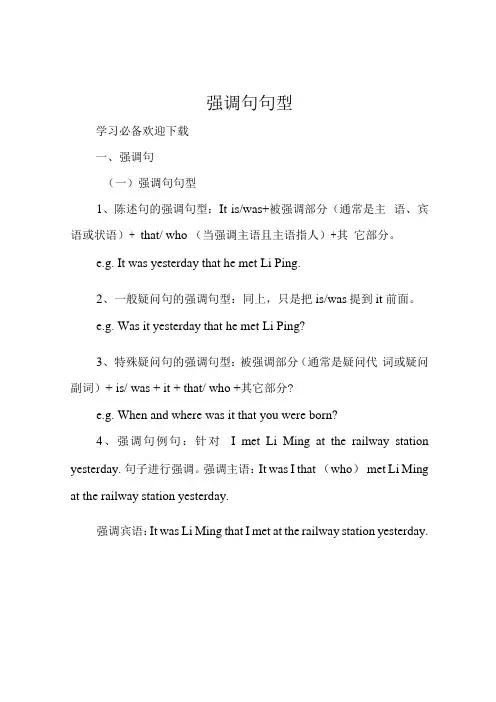
强调句句型学习必备欢迎下载一、强调句(一)强调句句型1、陈述句的强调句型:It is/was+被强调部分(通常是主语、宾语或状语)+ that/ who (当强调主语且主语指人)+其它部分。
e.g. It was yesterday that he met Li Ping.2、一般疑问句的强调句型:同上,只是把is/was提到it 前面。
e.g. Was it yesterday that he met Li Ping?3、特殊疑问句的强调句型:被强调部分(通常是疑问代词或疑问副词)+ is/ was + it + that/ who +其它部分?e.g. When and where was it that you were born?4、强调句例句:针对I met Li Ming at the railway station yesterday.句子进行强调。
强调主语:It was I that (who) met Li Ming at the railway station yesterday.强调宾语:It was Li Ming that I met at the railway station yesterday.强调地点状语:It was at the railway station that I met LiMing yesterday.强调时间状语:It was yesterday that I met Li Ming at the railway station.5、注意:构成强调句的it本身没有词义;强调句中的连接词一般只用that, who,即使在强调时间状语和地点状语时也如此,that, who 不可省略;强调句中的时态只用两种,一般现在时和一般过去时。
原句谓语动词是一般过去时、过去完成时和过去进行时,用It was ...,其余的时态用It is ...o(二)not…Until…句型的强调句1、句型为:It is/ was not until +被强调部分+ that +其它部分e.g.普通句:He didn,t go to bed until/ till his wife came back.强调句:It was not until his wife came back that he went to bed.2、注意:此句型只用UntiL不用till。
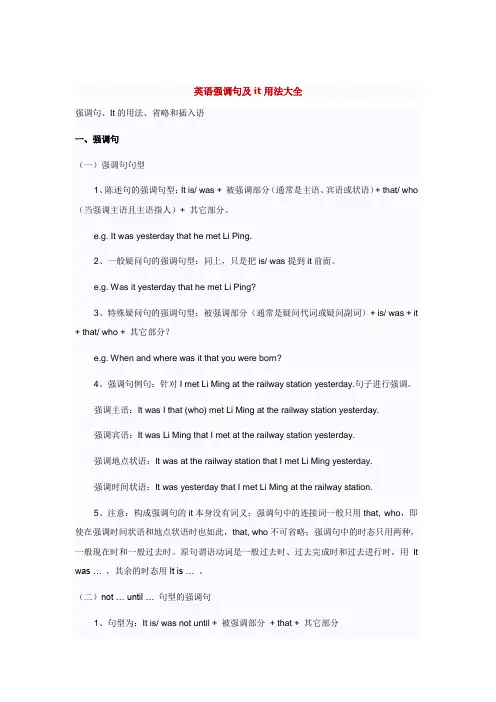
英语强调句及it用法大全强调句、It的用法、省略和插入语一、强调句(一)强调句句型1、陈述句的强调句型:It is/ was + 被强调部分(通常是主语、宾语或状语)+ that/ who (当强调主语且主语指人)+ 其它部分。
e.g. It was yesterday that he met Li Ping.2、一般疑问句的强调句型:同上,只是把is/ was提到it前面。
e.g. Was it yesterday that he met Li Ping?3、特殊疑问句的强调句型:被强调部分(通常是疑问代词或疑问副词)+ is/ was + it + that/ who + 其它部分?e.g. When and where was it that you were born?4、强调句例句:针对I met Li Ming at the railway station yesterday.句子进行强调。
强调主语:It was I that (who) met Li Ming at the railway station yesterday.强调宾语:It was Li Ming that I met at the railway station yesterday.强调地点状语:It was at the railway station that I met Li Ming yesterday.强调时间状语:It was yesterday that I met Li Ming at the railway station.5、注意:构成强调句的it本身没有词义;强调句中的连接词一般只用that, who,即使在强调时间状语和地点状语时也如此,that, who不可省略;强调句中的时态只用两种,一般现在时和一般过去时。
原句谓语动词是一般过去时、过去完成时和过去进行时,用It was … ,其余的时态用It is … 。
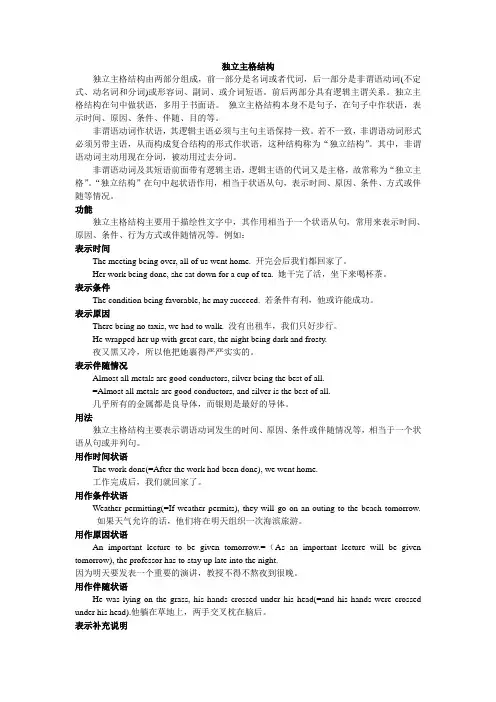
独立主格结构独立主格结构由两部分组成,前一部分是名词或者代词,后一部分是非谓语动词(不定式、动名词和分词)或形容词、副词、或介词短语。
前后两部分具有逻辑主谓关系。
独立主格结构在句中做状语,多用于书面语。
独立主格结构本身不是句子,在句子中作状语,表示时间、原因、条件、伴随、目的等。
非谓语动词作状语,其逻辑主语必须与主句主语保持一致。
若不一致,非谓语动词形式必须另带主语,从而构成复合结构的形式作状语,这种结构称为“独立结构”。
其中,非谓语动词主动用现在分词,被动用过去分词。
非谓语动词及其短语前面带有逻辑主语,逻辑主语的代词又是主格,故常称为“独立主格”。
“独立结构”在句中起状语作用,相当于状语从句,表示时间、原因、条件、方式或伴随等情况。
功能独立主格结构主要用于描绘性文字中,其作用相当于一个状语从句,常用来表示时间、原因、条件、行为方式或伴随情况等。
例如:表示时间The meeting being over, all of us went home. 开完会后我们都回家了。
Her work being done, she sat down for a cup of tea. 她干完了活,坐下来喝杯茶。
表示条件The condition being favorable, he may succeed. 若条件有利,他或许能成功。
表示原因There being no taxis, we had to walk. 没有出租车,我们只好步行。
He wrapped her up with great care, the night being dark and frosty.夜又黑又冷,所以他把她裹得严严实实的。
表示伴随情况Almost all metals are good conductors, silver being the best of all.=Almost all metals are good conductors, and silver is the best of all.几乎所有的金属都是良导体,而银则是最好的导体。
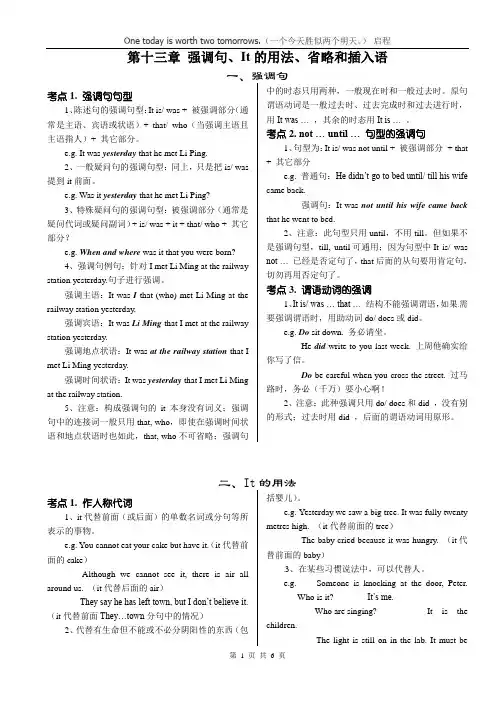
第十三章强调句、It的用法、省略和插入语一、强调句考点1. 强调句句型1、陈述句的强调句型:It is/ was + 被强调部分(通常是主语、宾语或状语)+ that/ who(当强调主语且主语指人)+ 其它部分。
e.g. It was yesterday that he met Li Ping.2、一般疑问句的强调句型:同上,只是把is/ was 提到it前面。
e.g. Was it yesterday that he met Li Ping?3、特殊疑问句的强调句型:被强调部分(通常是疑问代词或疑问副词)+ is/ was + it + that/ who + 其它部分?e.g. When and where was it that you were born?4、强调句例句:针对I met Li Ming at the railway station yesterday.句子进行强调。
强调主语:It was I that (who) met Li Ming at the railway station yesterday.强调宾语:It was Li Ming that I met at the railway station yesterday.强调地点状语:It was at the railway station that I met Li Ming yesterday.强调时间状语:It was yesterday that I met Li Ming at the railway station.5、注意:构成强调句的it本身没有词义;强调句中的连接词一般只用that, who,即使在强调时间状语和地点状语时也如此,that, who不可省略;强调句中的时态只用两种,一般现在时和一般过去时。
原句谓语动词是一般过去时、过去完成时和过去进行时,用It was … ,其余的时态用It is … 。
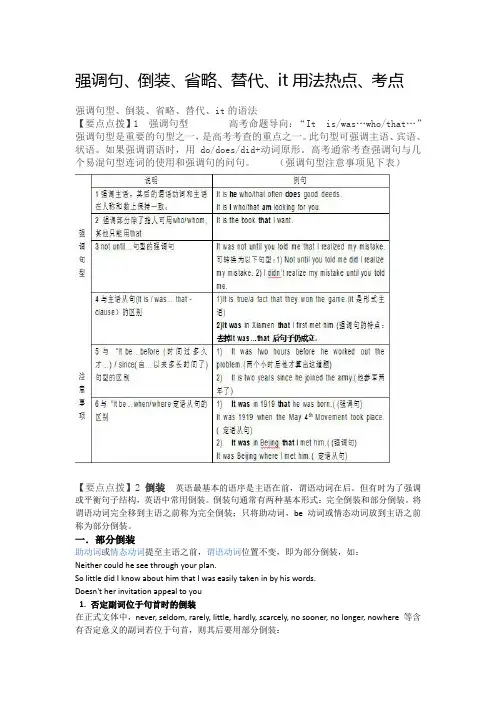
强调句、倒装、省略、替代、it用法热点、考点强调句型、倒装、省略、替代、it的语法【要点点拨】1 强调句型高考命题导向:“It is/was…who/that…”强调句型是重要的句型之一,是高考考查的重点之一。
此句型可强调主语、宾语、状语。
如果强调谓语时,用do/does/did+动词原形。
高考通常考查强调句与几个易混句型连词的使用和强调句的问句。
(强调句型注意事项见下表)【要点点拨】2 倒装英语最基本的语序是主语在前,谓语动词在后。
但有时为了强调或平衡句子结构,英语中常用倒装。
倒装句通常有两种基本形式:完全倒装和部分倒装。
将谓语动词完全移到主语之前称为完全倒装;只将助动词,be动词或情态动词放到主语之前称为部分倒装。
一.部分倒装助动词或情态动词提至主语之前,谓语动词位置不变,即为部分倒装,如:Neither could he see through your plan.So little did I know about him that I was easily taken in by his words.Doesn't her invitation appeal to you1. 否定副词位于句首时的倒装在正式文体中,never, seldom, rarely, little, hardly, scarcely, no sooner, no longer, nowhere 等含有否定意义的副词若位于句首,则其后要用部分倒装:I shall never forgive him._______________________我永远不会宽恕他。
He seldom goes out for dinner._______________________ ____他很少出去吃饭。
She hardly has time to listen to music.__________________________________. 她几乎没时间听音乐。
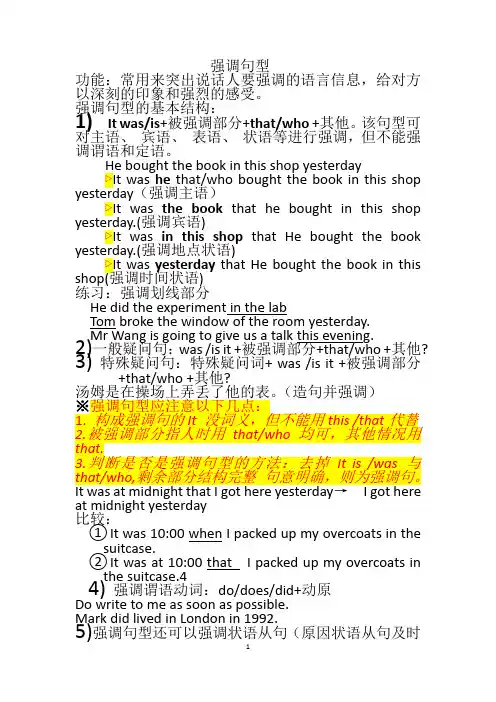
强调句型功能:常用来突出说话人要强调的语言信息,给对方以深刻的印象和强烈的感受。
强调句型的基本结构:1)It was/is+被强调部分+that/who +其他。
该句型可对主语、宾语、表语、状语等进行强调,但不能强调谓语和定语。
He bought the book in this shop yesterday▷It was he that/who bought the book in this shop yesterday(强调主语)▷It was the book that he bought in this shop yesterday.(强调宾语)▷It was in this shop that He bought the book yesterday.(强调地点状语)▷It was yesterday that He bought the book in this shop(强调时间状语)练习:强调划线部分He did the experiment in the labTom broke the window of the room yesterday.Mr Wang is going to give us a talk this evening.2)一般疑问句:was /is it +被强调部分+that/who +其他?3)特殊疑问句:特殊疑问词+ was /is it +被强调部分+that/who +其他?汤姆是在操场上弄丢了他的表。
(造句并强调)※强调句型应注意以下几点:1.构成强调句的It没词义,但不能用this /that代替2.被强调部分指人时用that/who均可,其他情况用that.3.判断是否是强调句型的方法:去掉It is /was 与that/who,剩余部分结构完整句意明确,则为强调句。
It was at midnight that Igot here yesterday→Igot here at midnight yesterday比较:①It was 10:00whenI packed up my overcoats in thesuitcase.②It was at 10:00 that I packed up my overcoats inthe suitcase.44)强调谓语动词:do/does/did+动原Do write to me as soon as possible.Mark did lived in London in 1992.5)强调句型还可以强调状语从句(原因状语从句及时间状语从句)It was because he behaved so badly tha t he was punished by the teacher.It was after he graduated from university tha t he settled here.注意:We didn’t realize he was a film star until he took off his dark glassesIt was not until he took off his dark glasses tha t we realized he was a film star.句型结构:It was/is not until …that…翻译句子:1)直到晚上十点我才上床睡觉。
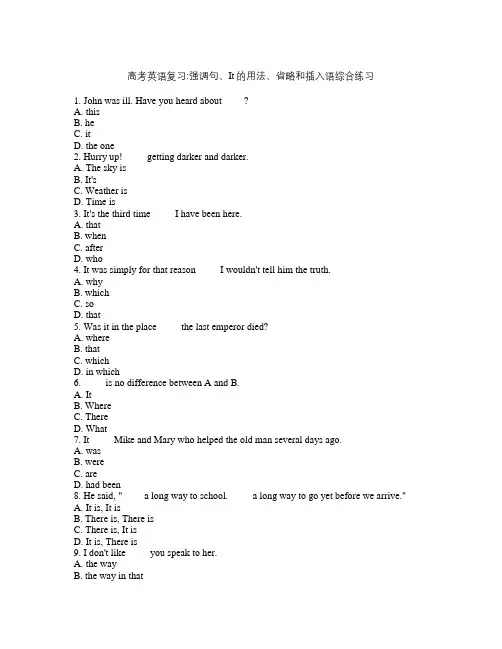
高考英语复习:强调句、It的用法、省略和插入语综合练习1. John was ill. Have you heard about ____?A. thisB. heC. itD. the one2. Hurry up! ____ getting darker and darker.A. The sky isB. It'sC. Weather isD. Time is3. It's the third time ____ I have been here.A. thatB. whenC. afterD. who4. It was simply for that reason ____ I wouldn't tell him the truth.A. whyB. whichC. soD. that5. Was it in the place ____ the last emperor died?A. whereB. thatC. whichD. in which6. ____ is no difference between A and B.A. ItB. WhereC. ThereD. What7. It ____ Mike and Mary who helped the old man several days ago.A. wasB. wereC. areD. had been8. He said, "____ a long way to school. ____ a long way to go yet before we arrive."A. It is, It isB. There is, There isC. There is, It isD. It is, There is9. I don't like ____ you speak to her.A. the wayB. the way in thatD. the way of which10. If you go to Xi'an, you'll find the palaces there more magnificent than commonly ____.A. supposingB. supposeC. to supposeD. supposed11. ____ is a fact that English is being accepted as an internationallanguage.A. ThereB. ThisC. ThatD. It12. It was about 600 years ago ____ the first clock with a face and anhour hand was made.A. thatB. untilC. beforeD. when13. It was not until 1920 ____ regular radio broadcast began.A. whileB. whichC. thatD. since14. ---- Do you mind my taking this seat?---- ____.A. Y es, sit down pleaseB. No, of course notC. Y es, take it pleaseD. No, you can't take it15. ---- I'll be away on a business trip. Would you mind looking after mycat?--- Not at all. ____.A. I've no timeB. I'd rather notC. I'd like itD. I'd be happy to16. The boy wanted to ride his bicycle in the street, but his mother told him _____.A. not toB. not to doC. not do itD. do not to17. It was not until she came to see us ____ her mother was ill in bed.A. when we knewB. that did we knewD. that did we know18. ---- This store has such high prices.---- I agree. Never again ____ here.A. I will shopB. will I shopC. I do shopD. shop I19. ____ was his kindness that everyone praised him.A. ItB. WhatC. SoD. Such20. ____, he would have passed the exam.A. If he were to studyB. If he studied hardC. Had he studied hardD. Should he study hard21. ---- David has made great progress recently. ---- ____, and ____.A. So he has, so have youB. So he has, so you haveC. So has he, so have youD. So has he, so you have22. No sooner ____ they rushed out into the street.A. did they hear the news thanB. did they hear the news whenC. had they heard the news thanD. had they heard the news when23. He was unable to make such progress, ____.A. hard as he triedB. as hard he triedC. hard he has triedD. tried hard as he答案:1~5 CBADB 6~10 CADAD 11~15 DACBD 16~20 ACBDC 21~23 ACA。

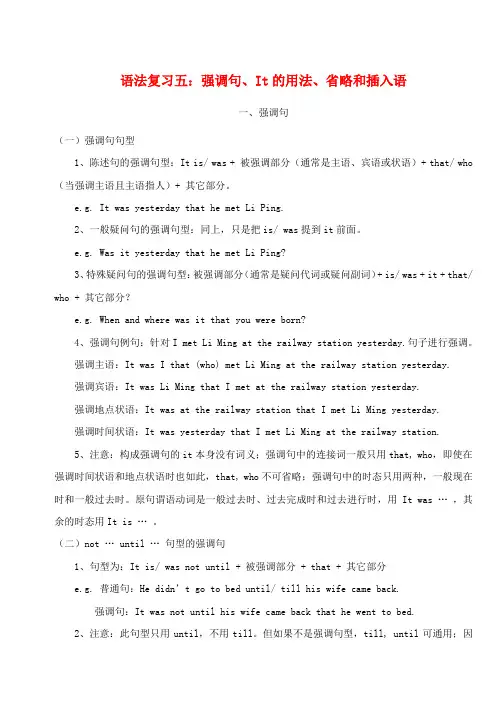
语法复习五:强调句、It的用法、省略和插入语一、强调句(一)强调句句型1、陈述句的强调句型:It is/ was + 被强调部分(通常是主语、宾语或状语)+ that/ who (当强调主语且主语指人)+ 其它部分。
e.g. It was yesterday that he met Li Ping.2、一般疑问句的强调句型:同上,只是把is/ was提到it前面。
e.g. Was it yesterday that he met Li Ping?3、特殊疑问句的强调句型:被强调部分(通常是疑问代词或疑问副词)+ is/ was + it + that/ who + 其它部分?e.g. When and where was it that you were born?4、强调句例句:针对I met Li Ming at the railway station yesterday.句子进行强调。
强调主语:It was I that (who) met Li Ming at the railway station yesterday.强调宾语:It was Li Ming that I met at the railway station yesterday.强调地点状语:It was at the railway station that I met Li Ming yesterday.强调时间状语:It was yesterday that I met Li Ming at the railway station.5、注意:构成强调句的it本身没有词义;强调句中的连接词一般只用that, who,即使在强调时间状语和地点状语时也如此,that, who不可省略;强调句中的时态只用两种,一般现在时和一般过去时。
原句谓语动词是一般过去时、过去完成时和过去进行时,用It was … ,其余的时态用It is … 。

语法讲义三强调句 It的用法一、强调句(一)强调句句型1、陈述句的强调句型:It is/ was + 被强调部分(通常是主语、宾语或状语)+ that/ who (当强调主语且主语指人)+ 其它部分。
e.g. It was yesterday that he met Li Ping.2、一般疑问句的强调句型:同上,只是把is/ was提到it前面。
e.g. Was it yesterday that he met Li Ping?3、特殊疑问句的强调句型:被强调部分(通常是疑问代词或疑问副词)+ is/ was + it + that/ who + 其它部分?e.g. When and where was it that you were born?4、强调句例句:针对I met Li Ming at the railway station yesterday.句子进行强调。
强调主语:It was I that (who) met Li Ming at the railway station yesterday.强调宾语:It was Li Ming that I met at the railway station yesterday.强调地点状语:It was at the railway station that I met Li Ming yesterday.强调时间状语:It was yesterday that I met Li Ming at the railway station.5、注意:构成强调句的it本身没有词义;强调句中的连接词一般只用that, who,即使在强调时间状语和地点状语时也如此,that, who不可省略;强调句中的时态只用两种,一般现在时和一般过去时。
原句谓语动词是一般过去时、过去完成时和过去进行时,用It was … ,其余的时态用It is … 。
(二)not … until … 句型的强调句1、句型为:It is/ was not until + 被强调部分+ that + 其它部分e.g. 普通句:He didn’t go to bed until/ till his wife came back.强调句:It was not until his wife came back that he went to bed.2、注意:此句型只用until,不用till。
高考英语语法复习:强调句、IT的用法、省略和插入语句一、强调句(一)强调句句型1、陈述句的强调句型:It is/ was + 被强调部分(通常是主语、宾语或状语)+ that/ who(当强调主语且主语指人)+ 其它部分。
e.g. It was yesterday that he met Li Ping.2、一般疑问句的强调句型:同上,只是把is/ was提到it前面。
e.g. Was it yesterday that he met Li Ping?3、特殊疑问句的强调句型:被强调部分(通常是疑问代词或疑问副词)+ is/ was + it + that/ who + 其它部分?e.g. When and where was it that you were born?4、强调句例句:针对I met Li Ming at the railway station yesterday.句子进行强调。
强调主语:It was I that (who) met Li Ming at the railway station yesterday.强调宾语:It was Li Ming that I met at the railway station yesterday.强调地点状语:It was at the railway station that I met Li Ming yesterday.强调时间状语:It was yesterday that I met Li Ming at the railway station.5、注意:构成强调句的it本身没有词义;强调句中的连接词一般只用that, who,即使在强调时间状语和地点状语时也如此,that, who不可省略;强调句中的时态只用两种,一般现在时和一般过去时。
原句谓语动词是一般过去时、过去完成时和过去进行时,用It was … ,其余的时态用It is … 。
高考总复习:it用法及强调句型真题再现1. It was not until I came here ______ I realized this place was famous, for not only its beauty but also its weather.A. whoB. thatC. whereD. before2. It was 80 years before Christopher Columbus crossed the Atlantic______ Zheng sailed to East Africa.A. whenB. thatC. afterD. since3. Sarah made _______ to the airport just in time to catch her plane this morning.A. herselfB. thisC. thatD. it4. If you’re buying today’s paper fr om the stand, could you get for me?A. oneB. suchC. thisD. that5. Studying Wendy’s menu, I found that many of the items are similar to ____ of McDonald’s.A. thoseB. oneC. anyD. all6. No matter where he is, he makes _____a rule to go for a walk before breakfast.A. him B this C. that D. it7. This is not my story, nor ______ the whole story. My story plays out differently.A. is thereB. there isC. is itD. it is1. B。
强调句、It的用法、省略和插入语专项复习(No.14)强调句、It的用法、省略和插入语专项复习一、强调句(一)强调句句型1、陈述句的强调句型:It is/ was + 被强调部分(通常是主语、宾语或状语)+ that/ who(当强调主语且主语指人)+ 其它部分。
e.g. It was yesterday that he met Li Ping.2、强调句例句:针对I met Li Ming at the railway station yesterday.句子进行强调。
强调主语:It was I that (who) met Li Ming at the railway station yesterday.强调宾语:It was Li Ming that I met at the railway station yesterday.强调地点状语:It was at the railway station that I met Li Ming yesterday.强调时间状语:It was yesterday that I met Li Ming at the railway station.注意:1. 句首词用“It”,不能用“This”,“That”等。
且构成强调句的it本身没有词义;强调句中的连接词一般只用that, who,即使在强调时间状语和地点状语时也如此,that, who不可省略2. 、强调句中的时态只用两种,一般现在时和一般过去时。
原句谓语动词是一般过去时、过去完成时和过去进行时,用It was … ,其余的时态用It i s … 。
3. 被强调的部分如果是代词,强调主语用主格,强调宾语用宾格。
e.g. It is him that (who/ whom) I met in the street yesterday.It is I who am wrong.4. 其他部分中的主谓一致问题。
1.强调句 .......................................................................................................................................... - 1 -2.It的用法....................................................................................................................................... - 1 -3.省略 .............................................................................................................................................. - 2 -4、插入语 ....................................................................................................................................... - 3 -5.倒装句 .......................................................................................................................................... - 4 -6.基础练习 ...................................................................................................................................... - 6 -7. 高考试题 .................................................................................................................................... - 8 -8. 模拟试题 .................................................................................................................................... - 9 -1.强调句(一)强调句句型1、陈述句的强调句型:It is/ was + 被强调部分+ that/ who+ 其它部分。
语法复习五:强调句、It的用法、省略和插入语一、强调句(一)强调句句型1、陈述句的强调句型:It is/ was + 被强调部分(通常是主语、宾语或状语)+ that/ who(当强调主语且主语指人)+ 其它部分。
e.g. It was yesterday that he met Li Ping.2、一般疑问句的强调句型:同上,只是把is/ was提到it前面。
e.g. Was it yesterday that he met Li Ping?3、特殊疑问句的强调句型:被强调部分(通常是疑问代词或疑问副词)+ is/ was + it + that/ who + 其它部分?e.g. When and where was it that you were born?4、强调句例句:针对I met Li Ming at the railway station yesterday.句子进行强调。
强调主语:It was I that (who) met Li Ming at the railway station yesterday.强调宾语:It was Li Ming that I met at the railway station yesterday.强调地点状语:It was at the railway station that I met Li Ming yesterday.强调时间状语:It was yesterday that I met Li Ming at the railway station.5、注意:构成强调句的it本身没有词义;强调句中的连接词一般只用that, who,即使在强调时间状语和地点状语时也如此,that, who不可省略;强调句中的时态只用两种,一般现在时和一般过去时。
原句谓语动词是一般过去时、过去完成时和过去进行时,用It was … ,其余的时态用It is … 。
(二)not … until … 句型的强调句1、句型为:It is/ was not until + 被强调部分+ that + 其它部分e.g. 普通句:He didn’t go to bed until/ till his wife came back.强调句:It was not until his wife came back that he went to bed.2、注意:此句型只用until,不用till。
但如果不是强调句型,till, until可通用;因为句型中It is/ was not … 已经是否定句了,that后面的从句要用肯定句,切勿再用否定句了。
(三)谓语动词的强调1、It is/ was … that … 结构不能强调谓语,如果需要强调谓语时,用助动词do/ does或did。
e.g. Do sit down. 务必请坐。
He did write to you last week. 上周他确实给你写了信。
Do be careful when you cross the street. 过马路时,务必(千万)要小心啊!2、注意:此种强调只用do/ does和did ,没有别的形式;过去时用did ,后面的谓语动词用原形。
二、It的用法(一)作人称代词1、it代替前面(或后面)的单数名词或分句等所表示的事物。
e.g. You cannot eat your cake but have it.(it代替前面的cake)Although we cannot see it, there is air all around us. (it代替后面的air)They say he has left town, but I don’t believe it.(it代替前面They…town分句中的情况)2、代替有生命但不能或不必分阴阳性的东西(包括婴儿)。
e.g. Yesterday we saw a big tree. It was fully twenty metres high. (it代替前面的tree)The baby cried because it was hungry. (it代替前面的baby)3、在某些习惯说法中,可以代替人。
e.g. ---- Someone is knocking at the door, Peter. ---- Who is it? ---- It’s me.---- Who are singing? ---- It is the children.---- The light is still on in the lab. It must be the third-year students doing the experiment.4、it与one的区别:这两个词都可以代表前面说过的名词,但it用于同名同物的场合;one则用于同名异物的场合。
e.g. ---- Do you still have the bicycle? ---- No, I have sold it.---- Is this knife yours? ---- No. It is Xiao Zhang’s. Mine is the one on the desk.5、it与that的区别:两词都可代替某一特定名词,但that指同一类,并非同一个。
e.g. The climate of South China is mild(温和的); I like it very much.(it指the climate of South China)The climate of South China is much better than that of Japan.(that指the climate)(二)作无人称代词it作无人称代词时,除了句中找不到它所代表的词语外,另一个特点是它后面的内容都是表示天气、时间、距离、度量衡及情况等。
It is fine (rainy, windy, etc.).It is noon.It is a half hour’s walk to the factory.It is eighteen square metres in area.What does it matter?(三)作强调词,构成强调结构用以帮助改变句子结构,使句子的某一成分受到强调。
“It is (was) + 所强调的成分+ that (who) + 其它成分。
”在这个句型中,it本身没有词义。
详见“一、强调句”。
(四)引导词it作形式主语(宾语)为了使句子平衡,常采用形式主语(或宾语)it ,而把真正的主语(或宾语)置于句子后面。
通常引导词it与它所代替的句子成分中间要夹有某些词。
e.g. It takes half an hour to go there on foot.(It与to go there on foot之间夹有takes half an hour四个词)We thought it strange that Mr Smith did not come last night. (it与that从句中间夹有strange)但有时it与所替代部分之间并不夹有其它词。
e.g. You may depend on it that they will support you.(因为介词on之后一般不直接接that引导的宾语从句。
注意:it不是多余的,不能当作错句)练习一、强调句、It的用法1. My bike is missing. I can’t find ____ anywhere.A. oneB. onesC. itD. that2. ---- Who’s that?---- ____ Professor Li.A. That’sB. It’sC. He’sD. This’s3. ____ was Jane that I saw in the library this morning.A. ItB. HeC. SheD. That4. ---- Have you ever seen a whale alive? ---- Yes, I’ve seen ____.A. thatB. itC. suchD. one5. The color of my coat is different from ____ of yours.A. thisB. thatC. itD. one6. ____ will do you good to do some exercise every morning.A. ItB. ThereC. ThoseD. You7. We think ____ our duty to pay taxes to our government.A. thatB. thisC. itsD. it8. The climate of Shanghai is better than ____ of Nanjing.A. thatB. itC. whichD. what9. ____ four years since I joined the Army.A. There wasB. There isC. It wasD. It is10. How long ____ to finish the work?A. you’ll takeB. you’ll take itC. will it take youD. will take you11. It was through Xiao Li ____ I got to know Xiao Wang.A. whoB. whomC. howD. that12. It was in the rice fields ____ we had our league meeting.A. whereB. thatC. in whichD. on which13. It was on October 1st ____ new China was founded.A. whichB. whenC. asD. that14. Was it because he was ill ____ he asked for leave?A. andB. thatC. that’sD. so15. Mary speaks in a low voice; ____ is difficult to know what she is saying.A. itB. thatC. soD. she16. It was ____ I met Mr Green in Shanghai.A. many years thatB. many years beforeC. many years ago thatD. many years when17. ____ is not everybody ____ can draw so well.A. It, allB. It, thatC. There, whoD. There, that18. So ____ that no fish can live in it.A. shallow is the lakeB. the lake is shallowC. shallow the lake isD. is the lake shallow三、省略为了使讲话和行文简洁,句中某些成分有时可省略。